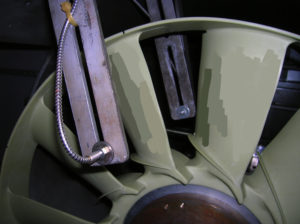INDUSTRIES / Energy / Fan Test Machine

Trucks and other heavy vehicles are at the top of the list of most energy consuming vehicles, and with that also at the top of most polluting vehicles. Our customers are doing everything they can to reduce the energy consumption of peripheral engine components that reduce the vehicle efficiency. One of those components is the fan, including the visco coupling, of trucks and other heavy vehicles.
Consider the machine as one big air tunnel, where the fan (test object) is also the fan that circulates the air within the tunnel.
The fan is driven by a 228 kW servo engine and controlled between 0 and 5000 RPM. The generated torque runs up to 800 Nm and is measured constantly with a HBM torque sensor. The servo motor is placed outside the wind tunnel and is mounted on its own frame in order to reduce vibrations in the driveline.
The flow and pressure built up in the wind tunnel is regulated by a set of fins, covering an area of one square meter. A second servo drive actively controls the pressure that is built up behind the fan.
The air inside the wind tunnel can be heated to 150 degrees Celsius, which required special high temperature components and wiring. The temperature is generated by a 30kW heater in the main flow and is controlled by a set of four thermocouples at the inlet site of the fan.
 |
||
 |
||
Some of the fans are not direct driven by the engine, but the RPM is regulated ty a visco coupling. On the one hand they are more efficient at higher speeds, where drive wind cools down the engine, but on the other hand the are less efficient as the direct driven ones, because they lose energy within the coupling. This coupling is controlled by temperature changing the viscosity, which is done by a local 10kW heating directly aimed at the coupling. By activating the heat source, the drive ratio of the fan can be regulated.
Key words:
- - Heat and noise reduced cabin
- - Outside temperature max. 50 degrees Celsius
- - Outside noise max. 90 dB (Reduction of 30 dB by the cabin)
- - Servo drive of 228 kW and 800 Nm
- - Servo controlled pressure in the wind tunnel
- - Easy access for changing 900mm fans
- - Vertical and horizontal vibration measurement at the fan
- - Balanced driveline
- - FEA and vibration analysis on driveline and structures
- - Safety doors with safety glass
- - Electronics and measurement equipment in separate room
For more information please contact our Sales
Call +31 45 543 9251 or e-mail sales@gdo-bv.com
